Documentary Analysis: Unmediated Truth in Nanook and Super Size Me
VerifiedAdded on 2023/04/11
|10
|1871
|407
Essay
AI Summary
This essay provides a comprehensive analysis of two influential documentaries: Robert J. Flaherty's "Nanook of The North" and Morgan Spurlock's "Super Size Me." The essay begins by defining the concept of unmediated truth in documentary filmmaking, contrasting it with the potential for directorial intervention and staged elements. "Nanook of The North" is examined for its historical context and the extent to which it deviates from pure non-fiction through staged scenes and directorial instructions, potentially blurring the lines between fiction and non-fiction. In contrast, "Super Size Me" is presented as a prime example of a documentary adhering to the principles of unmediated truth, showcasing Spurlock's personal experiment with fast food consumption and its subsequent effects on his health and well-being. The essay concludes by highlighting the significance of both documentaries, emphasizing their contributions to the evolution of documentary filmmaking and their respective impacts on film studies.
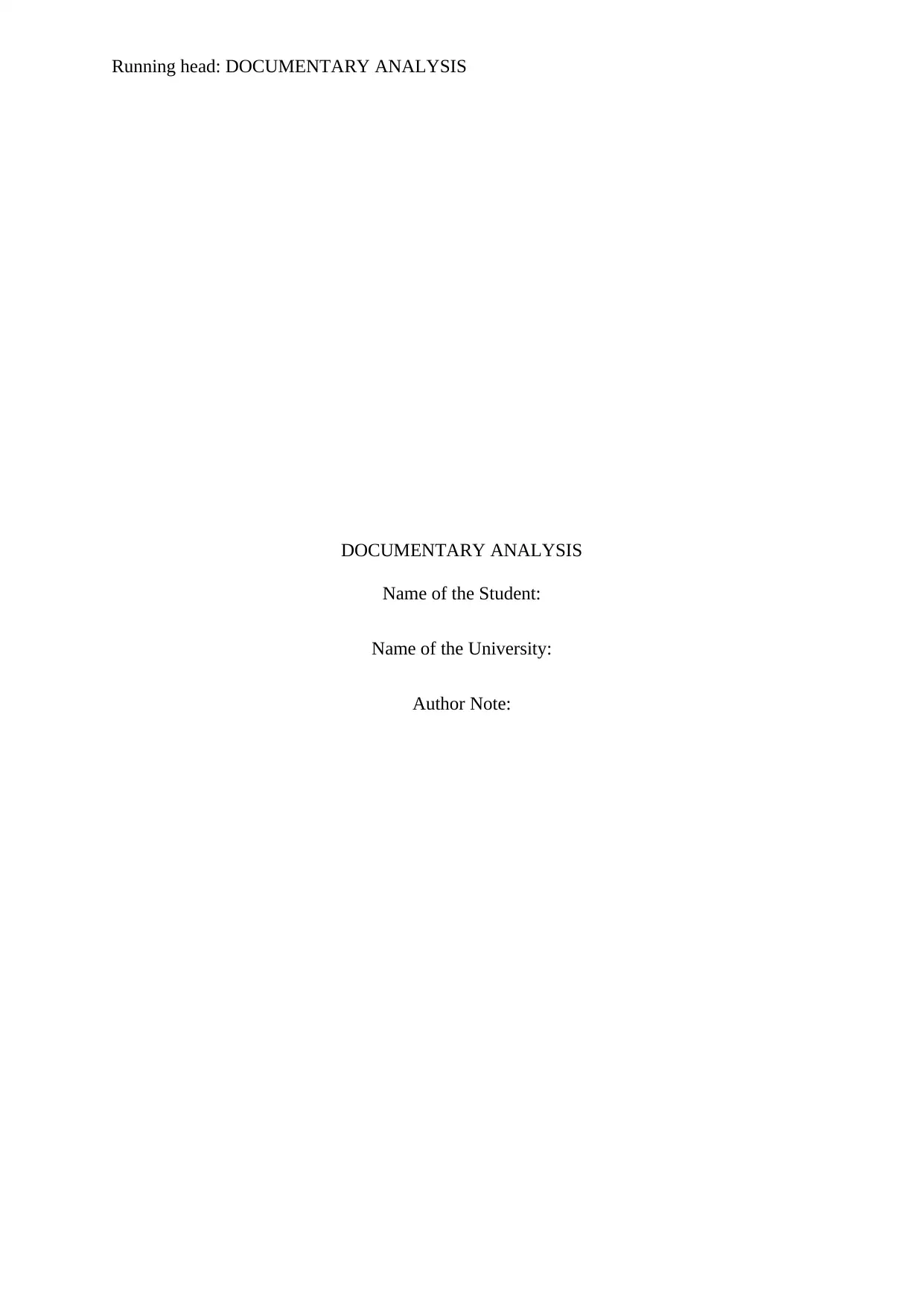
Running head: DOCUMENTARY ANALYSIS
DOCUMENTARY ANALYSIS
Name of the Student:
Name of the University:
Author Note:
DOCUMENTARY ANALYSIS
Name of the Student:
Name of the University:
Author Note:
Paraphrase This Document
Need a fresh take? Get an instant paraphrase of this document with our AI Paraphraser
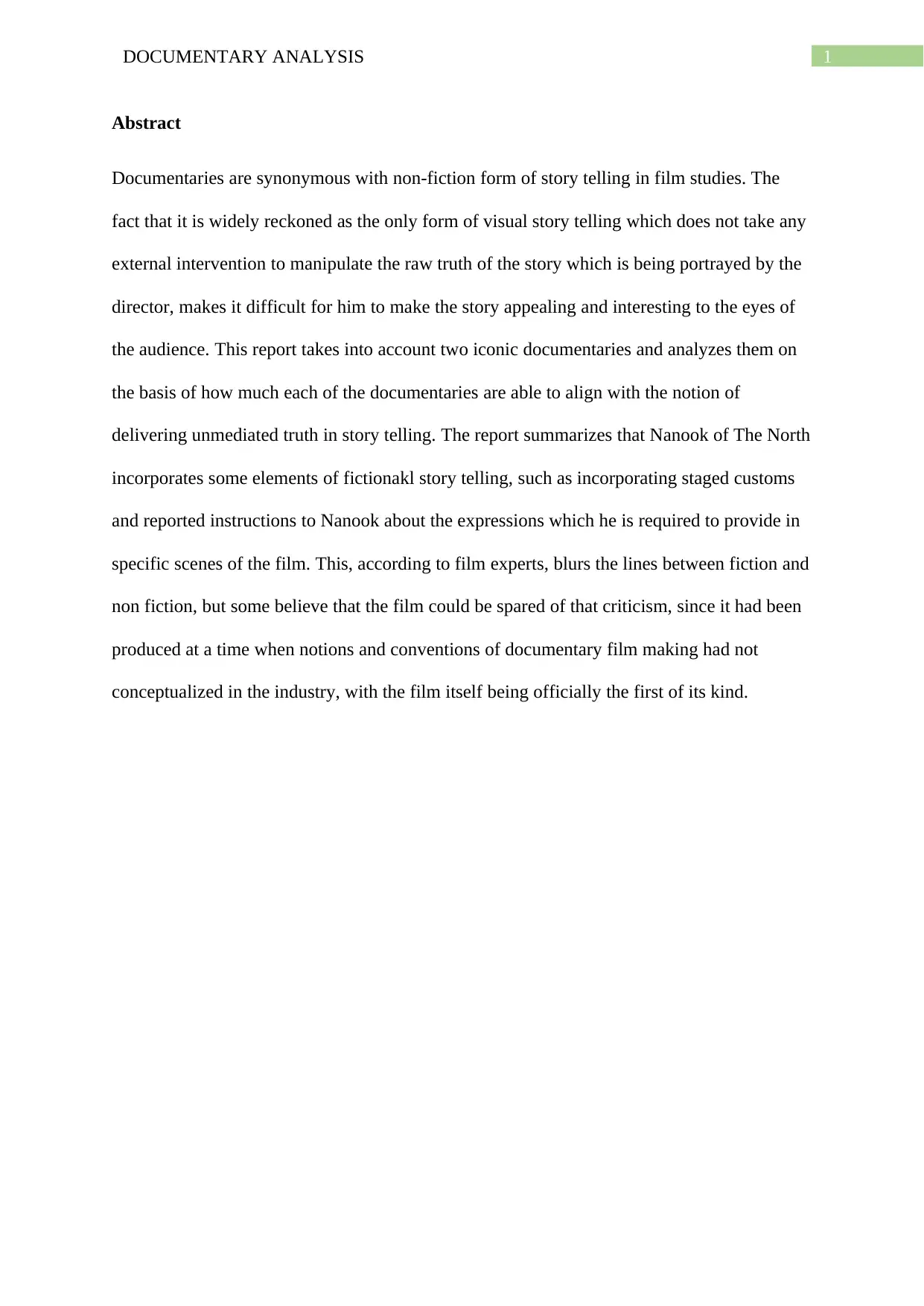
1DOCUMENTARY ANALYSIS
Abstract
Documentaries are synonymous with non-fiction form of story telling in film studies. The
fact that it is widely reckoned as the only form of visual story telling which does not take any
external intervention to manipulate the raw truth of the story which is being portrayed by the
director, makes it difficult for him to make the story appealing and interesting to the eyes of
the audience. This report takes into account two iconic documentaries and analyzes them on
the basis of how much each of the documentaries are able to align with the notion of
delivering unmediated truth in story telling. The report summarizes that Nanook of The North
incorporates some elements of fictionakl story telling, such as incorporating staged customs
and reported instructions to Nanook about the expressions which he is required to provide in
specific scenes of the film. This, according to film experts, blurs the lines between fiction and
non fiction, but some believe that the film could be spared of that criticism, since it had been
produced at a time when notions and conventions of documentary film making had not
conceptualized in the industry, with the film itself being officially the first of its kind.
Abstract
Documentaries are synonymous with non-fiction form of story telling in film studies. The
fact that it is widely reckoned as the only form of visual story telling which does not take any
external intervention to manipulate the raw truth of the story which is being portrayed by the
director, makes it difficult for him to make the story appealing and interesting to the eyes of
the audience. This report takes into account two iconic documentaries and analyzes them on
the basis of how much each of the documentaries are able to align with the notion of
delivering unmediated truth in story telling. The report summarizes that Nanook of The North
incorporates some elements of fictionakl story telling, such as incorporating staged customs
and reported instructions to Nanook about the expressions which he is required to provide in
specific scenes of the film. This, according to film experts, blurs the lines between fiction and
non fiction, but some believe that the film could be spared of that criticism, since it had been
produced at a time when notions and conventions of documentary film making had not
conceptualized in the industry, with the film itself being officially the first of its kind.

2DOCUMENTARY ANALYSIS
⊘ This is a preview!⊘
Do you want full access?
Subscribe today to unlock all pages.

Trusted by 1+ million students worldwide
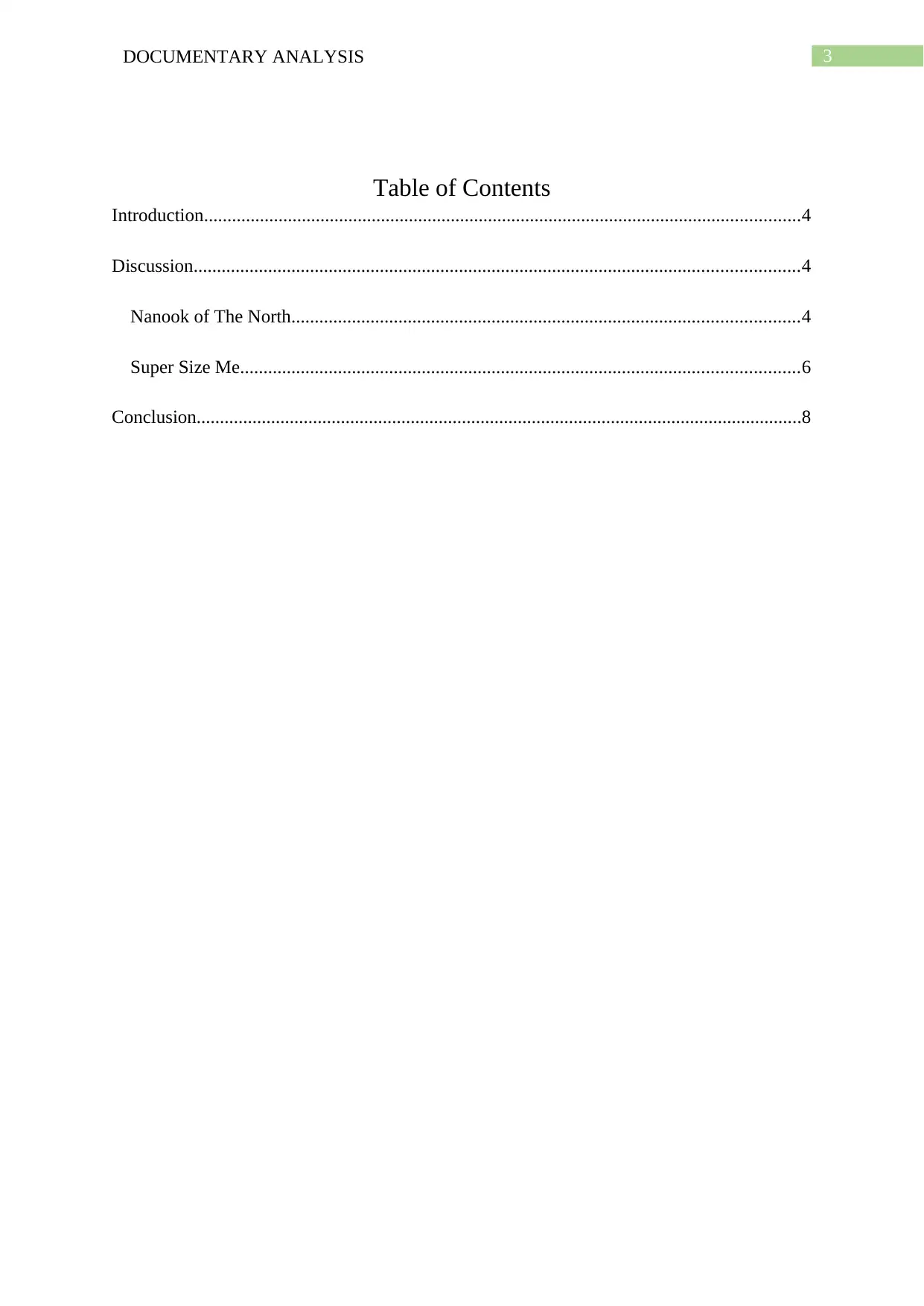
3DOCUMENTARY ANALYSIS
Table of Contents
Introduction................................................................................................................................4
Discussion..................................................................................................................................4
Nanook of The North.............................................................................................................4
Super Size Me........................................................................................................................6
Conclusion..................................................................................................................................8
Table of Contents
Introduction................................................................................................................................4
Discussion..................................................................................................................................4
Nanook of The North.............................................................................................................4
Super Size Me........................................................................................................................6
Conclusion..................................................................................................................................8
Paraphrase This Document
Need a fresh take? Get an instant paraphrase of this document with our AI Paraphraser
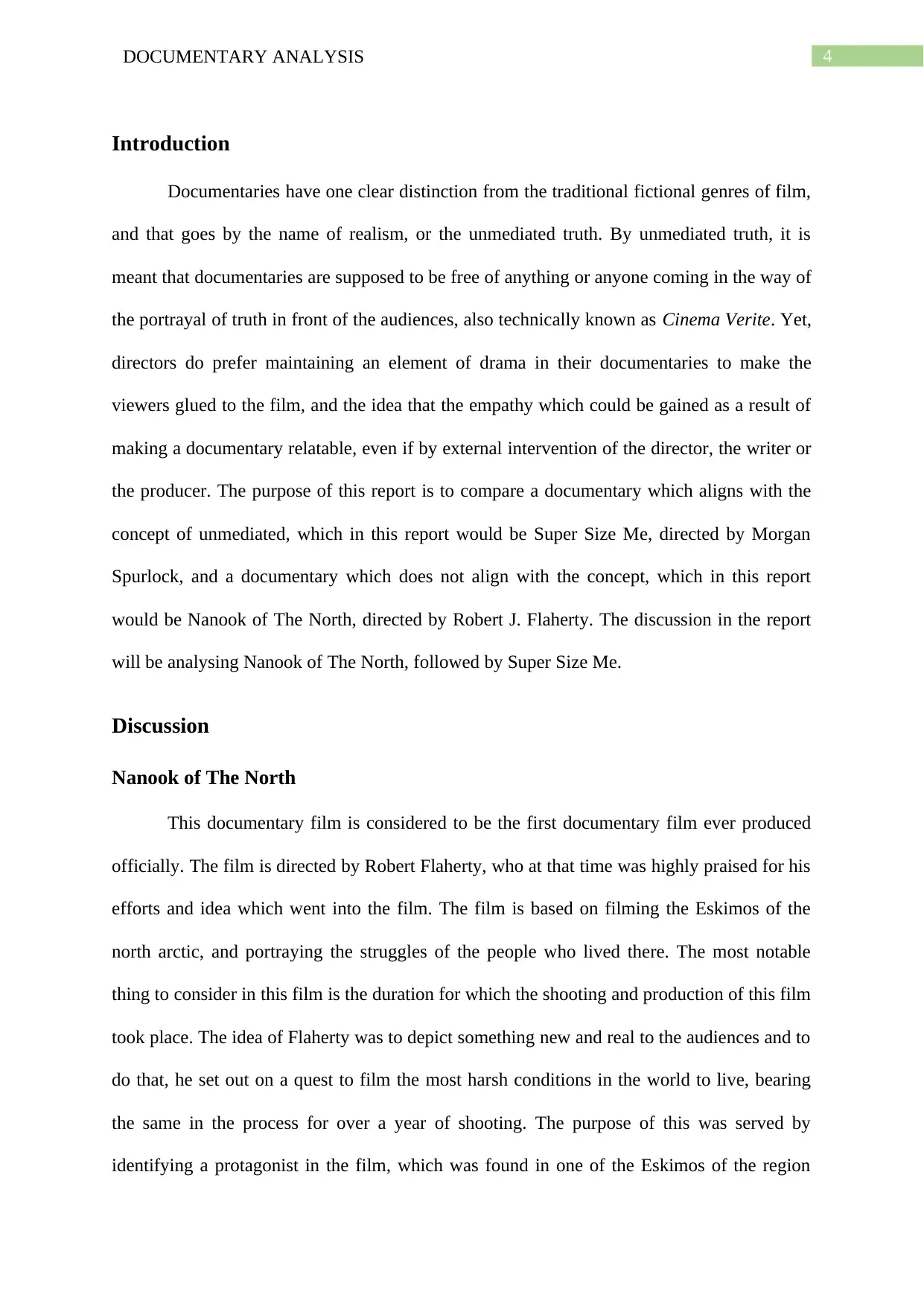
4DOCUMENTARY ANALYSIS
Introduction
Documentaries have one clear distinction from the traditional fictional genres of film,
and that goes by the name of realism, or the unmediated truth. By unmediated truth, it is
meant that documentaries are supposed to be free of anything or anyone coming in the way of
the portrayal of truth in front of the audiences, also technically known as Cinema Verite. Yet,
directors do prefer maintaining an element of drama in their documentaries to make the
viewers glued to the film, and the idea that the empathy which could be gained as a result of
making a documentary relatable, even if by external intervention of the director, the writer or
the producer. The purpose of this report is to compare a documentary which aligns with the
concept of unmediated, which in this report would be Super Size Me, directed by Morgan
Spurlock, and a documentary which does not align with the concept, which in this report
would be Nanook of The North, directed by Robert J. Flaherty. The discussion in the report
will be analysing Nanook of The North, followed by Super Size Me.
Discussion
Nanook of The North
This documentary film is considered to be the first documentary film ever produced
officially. The film is directed by Robert Flaherty, who at that time was highly praised for his
efforts and idea which went into the film. The film is based on filming the Eskimos of the
north arctic, and portraying the struggles of the people who lived there. The most notable
thing to consider in this film is the duration for which the shooting and production of this film
took place. The idea of Flaherty was to depict something new and real to the audiences and to
do that, he set out on a quest to film the most harsh conditions in the world to live, bearing
the same in the process for over a year of shooting. The purpose of this was served by
identifying a protagonist in the film, which was found in one of the Eskimos of the region
Introduction
Documentaries have one clear distinction from the traditional fictional genres of film,
and that goes by the name of realism, or the unmediated truth. By unmediated truth, it is
meant that documentaries are supposed to be free of anything or anyone coming in the way of
the portrayal of truth in front of the audiences, also technically known as Cinema Verite. Yet,
directors do prefer maintaining an element of drama in their documentaries to make the
viewers glued to the film, and the idea that the empathy which could be gained as a result of
making a documentary relatable, even if by external intervention of the director, the writer or
the producer. The purpose of this report is to compare a documentary which aligns with the
concept of unmediated, which in this report would be Super Size Me, directed by Morgan
Spurlock, and a documentary which does not align with the concept, which in this report
would be Nanook of The North, directed by Robert J. Flaherty. The discussion in the report
will be analysing Nanook of The North, followed by Super Size Me.
Discussion
Nanook of The North
This documentary film is considered to be the first documentary film ever produced
officially. The film is directed by Robert Flaherty, who at that time was highly praised for his
efforts and idea which went into the film. The film is based on filming the Eskimos of the
north arctic, and portraying the struggles of the people who lived there. The most notable
thing to consider in this film is the duration for which the shooting and production of this film
took place. The idea of Flaherty was to depict something new and real to the audiences and to
do that, he set out on a quest to film the most harsh conditions in the world to live, bearing
the same in the process for over a year of shooting. The purpose of this was served by
identifying a protagonist in the film, which was found in one of the Eskimos of the region
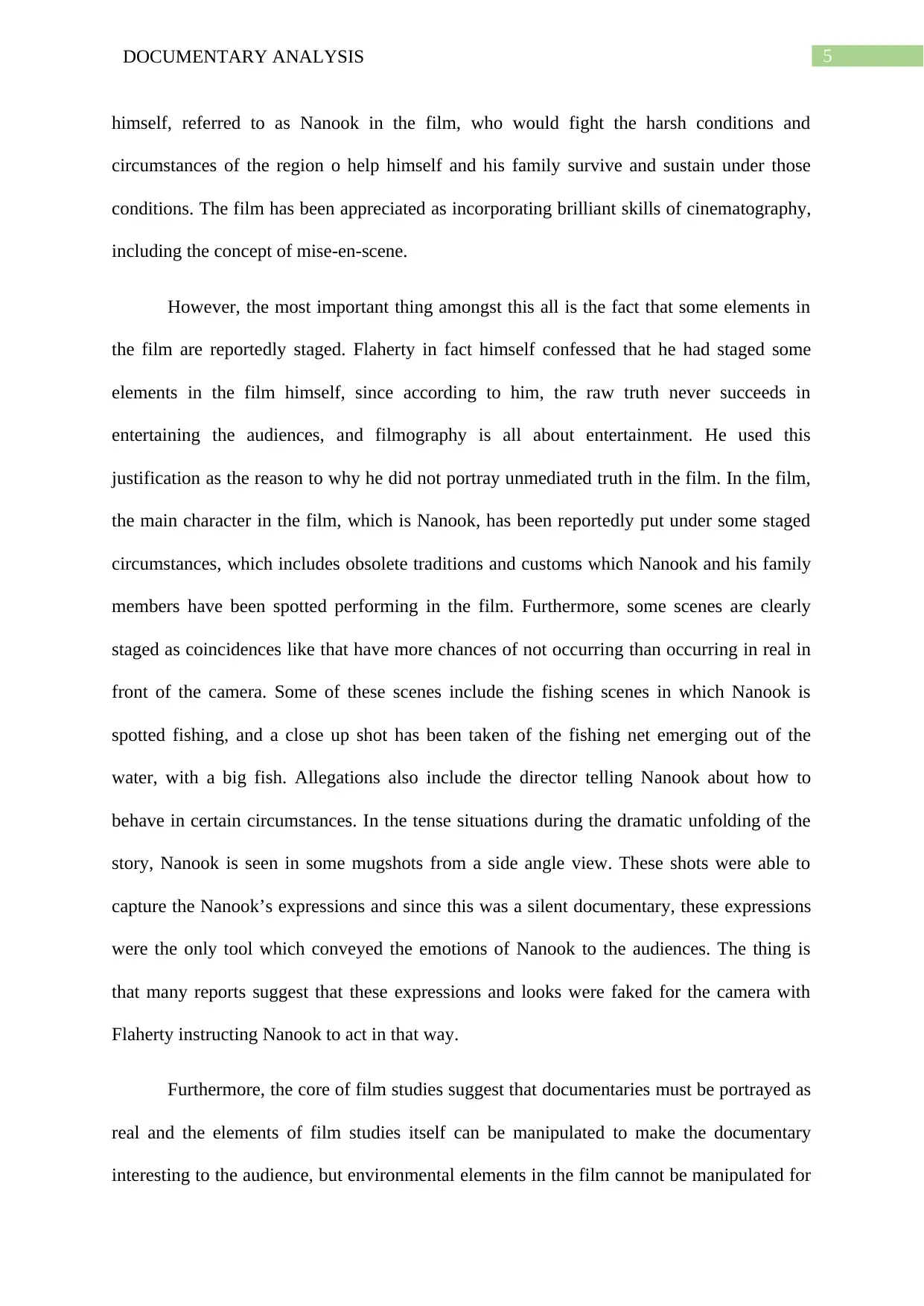
5DOCUMENTARY ANALYSIS
himself, referred to as Nanook in the film, who would fight the harsh conditions and
circumstances of the region o help himself and his family survive and sustain under those
conditions. The film has been appreciated as incorporating brilliant skills of cinematography,
including the concept of mise-en-scene.
However, the most important thing amongst this all is the fact that some elements in
the film are reportedly staged. Flaherty in fact himself confessed that he had staged some
elements in the film himself, since according to him, the raw truth never succeeds in
entertaining the audiences, and filmography is all about entertainment. He used this
justification as the reason to why he did not portray unmediated truth in the film. In the film,
the main character in the film, which is Nanook, has been reportedly put under some staged
circumstances, which includes obsolete traditions and customs which Nanook and his family
members have been spotted performing in the film. Furthermore, some scenes are clearly
staged as coincidences like that have more chances of not occurring than occurring in real in
front of the camera. Some of these scenes include the fishing scenes in which Nanook is
spotted fishing, and a close up shot has been taken of the fishing net emerging out of the
water, with a big fish. Allegations also include the director telling Nanook about how to
behave in certain circumstances. In the tense situations during the dramatic unfolding of the
story, Nanook is seen in some mugshots from a side angle view. These shots were able to
capture the Nanook’s expressions and since this was a silent documentary, these expressions
were the only tool which conveyed the emotions of Nanook to the audiences. The thing is
that many reports suggest that these expressions and looks were faked for the camera with
Flaherty instructing Nanook to act in that way.
Furthermore, the core of film studies suggest that documentaries must be portrayed as
real and the elements of film studies itself can be manipulated to make the documentary
interesting to the audience, but environmental elements in the film cannot be manipulated for
himself, referred to as Nanook in the film, who would fight the harsh conditions and
circumstances of the region o help himself and his family survive and sustain under those
conditions. The film has been appreciated as incorporating brilliant skills of cinematography,
including the concept of mise-en-scene.
However, the most important thing amongst this all is the fact that some elements in
the film are reportedly staged. Flaherty in fact himself confessed that he had staged some
elements in the film himself, since according to him, the raw truth never succeeds in
entertaining the audiences, and filmography is all about entertainment. He used this
justification as the reason to why he did not portray unmediated truth in the film. In the film,
the main character in the film, which is Nanook, has been reportedly put under some staged
circumstances, which includes obsolete traditions and customs which Nanook and his family
members have been spotted performing in the film. Furthermore, some scenes are clearly
staged as coincidences like that have more chances of not occurring than occurring in real in
front of the camera. Some of these scenes include the fishing scenes in which Nanook is
spotted fishing, and a close up shot has been taken of the fishing net emerging out of the
water, with a big fish. Allegations also include the director telling Nanook about how to
behave in certain circumstances. In the tense situations during the dramatic unfolding of the
story, Nanook is seen in some mugshots from a side angle view. These shots were able to
capture the Nanook’s expressions and since this was a silent documentary, these expressions
were the only tool which conveyed the emotions of Nanook to the audiences. The thing is
that many reports suggest that these expressions and looks were faked for the camera with
Flaherty instructing Nanook to act in that way.
Furthermore, the core of film studies suggest that documentaries must be portrayed as
real and the elements of film studies itself can be manipulated to make the documentary
interesting to the audience, but environmental elements in the film cannot be manipulated for
⊘ This is a preview!⊘
Do you want full access?
Subscribe today to unlock all pages.

Trusted by 1+ million students worldwide
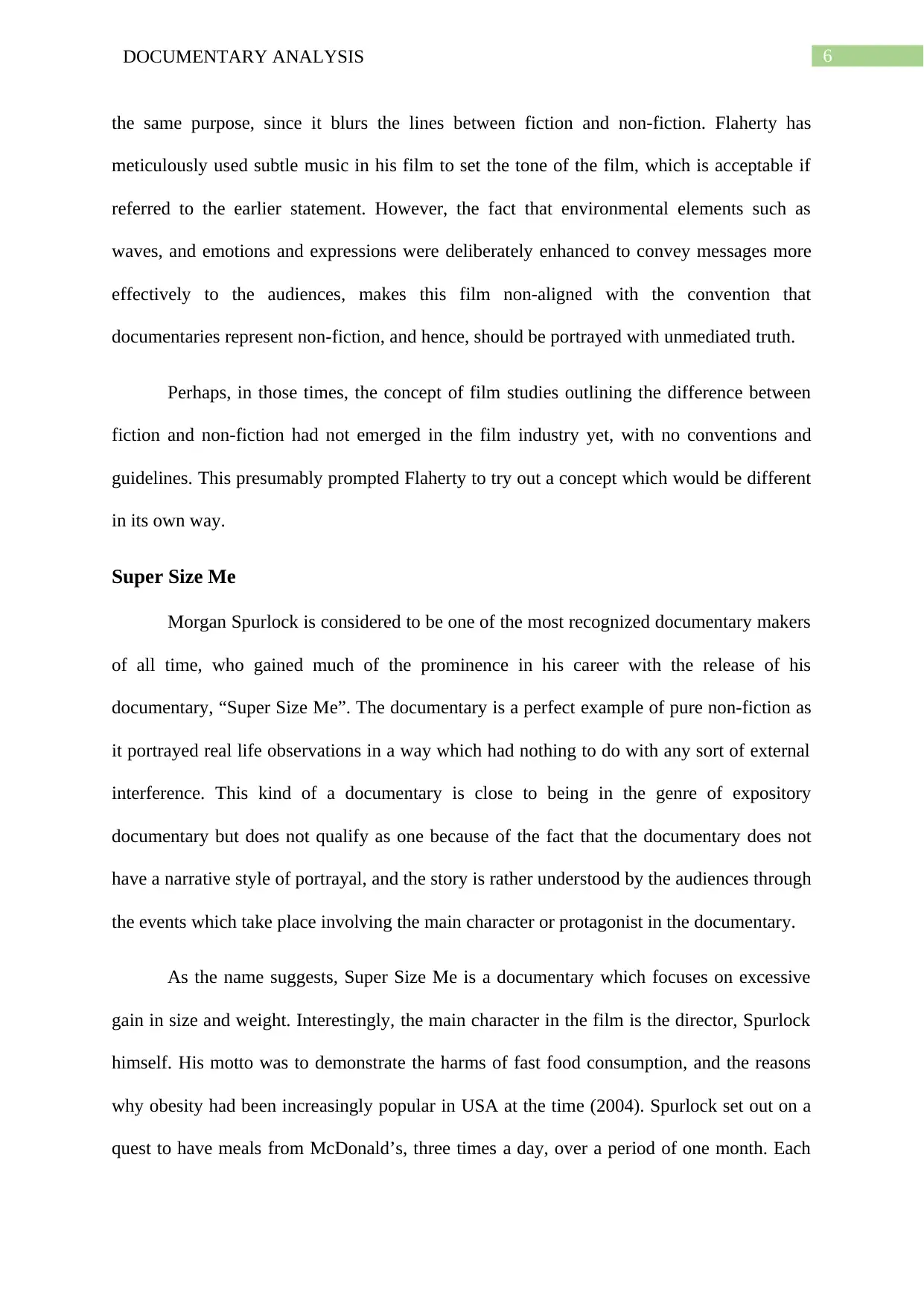
6DOCUMENTARY ANALYSIS
the same purpose, since it blurs the lines between fiction and non-fiction. Flaherty has
meticulously used subtle music in his film to set the tone of the film, which is acceptable if
referred to the earlier statement. However, the fact that environmental elements such as
waves, and emotions and expressions were deliberately enhanced to convey messages more
effectively to the audiences, makes this film non-aligned with the convention that
documentaries represent non-fiction, and hence, should be portrayed with unmediated truth.
Perhaps, in those times, the concept of film studies outlining the difference between
fiction and non-fiction had not emerged in the film industry yet, with no conventions and
guidelines. This presumably prompted Flaherty to try out a concept which would be different
in its own way.
Super Size Me
Morgan Spurlock is considered to be one of the most recognized documentary makers
of all time, who gained much of the prominence in his career with the release of his
documentary, “Super Size Me”. The documentary is a perfect example of pure non-fiction as
it portrayed real life observations in a way which had nothing to do with any sort of external
interference. This kind of a documentary is close to being in the genre of expository
documentary but does not qualify as one because of the fact that the documentary does not
have a narrative style of portrayal, and the story is rather understood by the audiences through
the events which take place involving the main character or protagonist in the documentary.
As the name suggests, Super Size Me is a documentary which focuses on excessive
gain in size and weight. Interestingly, the main character in the film is the director, Spurlock
himself. His motto was to demonstrate the harms of fast food consumption, and the reasons
why obesity had been increasingly popular in USA at the time (2004). Spurlock set out on a
quest to have meals from McDonald’s, three times a day, over a period of one month. Each
the same purpose, since it blurs the lines between fiction and non-fiction. Flaherty has
meticulously used subtle music in his film to set the tone of the film, which is acceptable if
referred to the earlier statement. However, the fact that environmental elements such as
waves, and emotions and expressions were deliberately enhanced to convey messages more
effectively to the audiences, makes this film non-aligned with the convention that
documentaries represent non-fiction, and hence, should be portrayed with unmediated truth.
Perhaps, in those times, the concept of film studies outlining the difference between
fiction and non-fiction had not emerged in the film industry yet, with no conventions and
guidelines. This presumably prompted Flaherty to try out a concept which would be different
in its own way.
Super Size Me
Morgan Spurlock is considered to be one of the most recognized documentary makers
of all time, who gained much of the prominence in his career with the release of his
documentary, “Super Size Me”. The documentary is a perfect example of pure non-fiction as
it portrayed real life observations in a way which had nothing to do with any sort of external
interference. This kind of a documentary is close to being in the genre of expository
documentary but does not qualify as one because of the fact that the documentary does not
have a narrative style of portrayal, and the story is rather understood by the audiences through
the events which take place involving the main character or protagonist in the documentary.
As the name suggests, Super Size Me is a documentary which focuses on excessive
gain in size and weight. Interestingly, the main character in the film is the director, Spurlock
himself. His motto was to demonstrate the harms of fast food consumption, and the reasons
why obesity had been increasingly popular in USA at the time (2004). Spurlock set out on a
quest to have meals from McDonald’s, three times a day, over a period of one month. Each
Paraphrase This Document
Need a fresh take? Get an instant paraphrase of this document with our AI Paraphraser
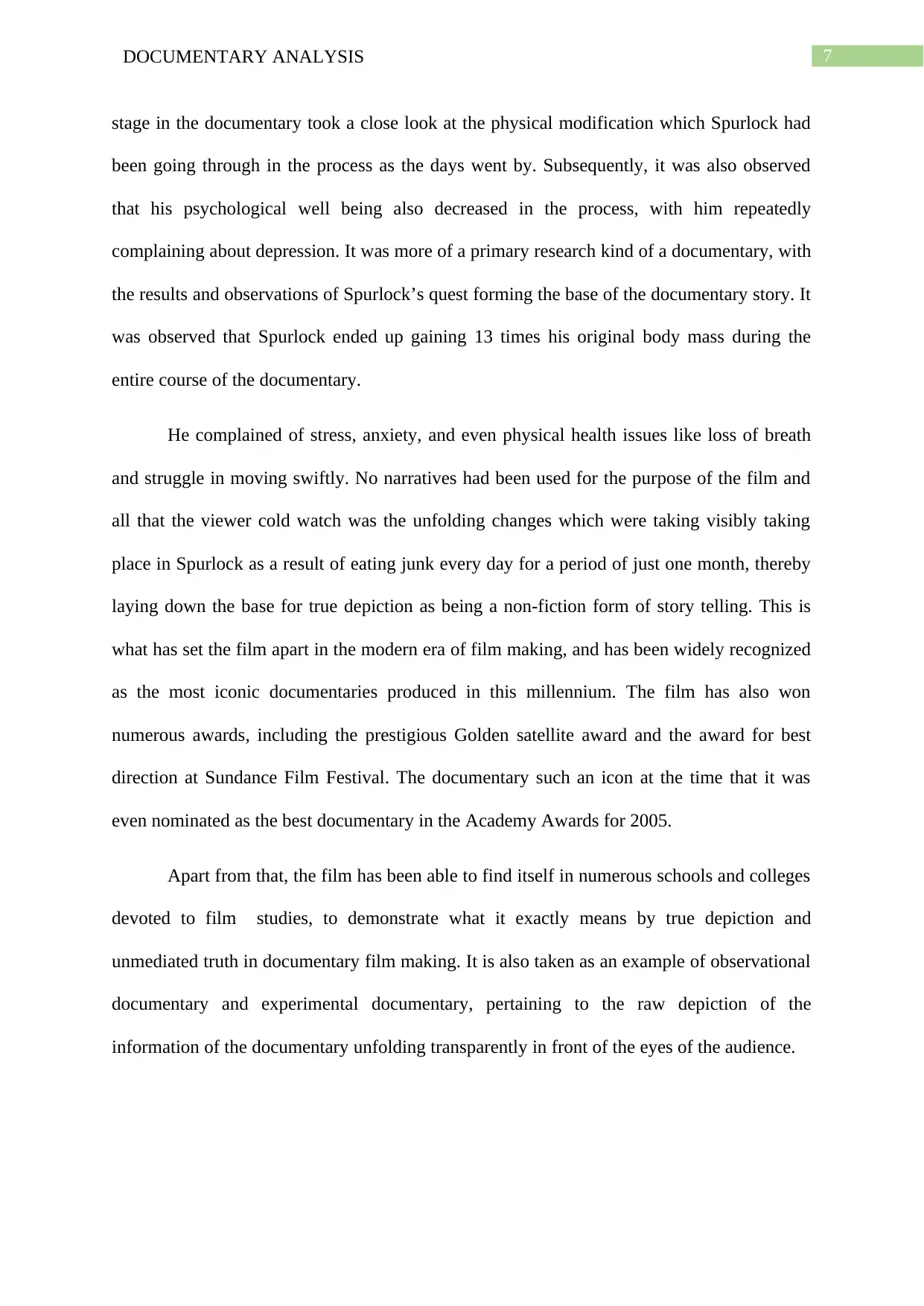
7DOCUMENTARY ANALYSIS
stage in the documentary took a close look at the physical modification which Spurlock had
been going through in the process as the days went by. Subsequently, it was also observed
that his psychological well being also decreased in the process, with him repeatedly
complaining about depression. It was more of a primary research kind of a documentary, with
the results and observations of Spurlock’s quest forming the base of the documentary story. It
was observed that Spurlock ended up gaining 13 times his original body mass during the
entire course of the documentary.
He complained of stress, anxiety, and even physical health issues like loss of breath
and struggle in moving swiftly. No narratives had been used for the purpose of the film and
all that the viewer cold watch was the unfolding changes which were taking visibly taking
place in Spurlock as a result of eating junk every day for a period of just one month, thereby
laying down the base for true depiction as being a non-fiction form of story telling. This is
what has set the film apart in the modern era of film making, and has been widely recognized
as the most iconic documentaries produced in this millennium. The film has also won
numerous awards, including the prestigious Golden satellite award and the award for best
direction at Sundance Film Festival. The documentary such an icon at the time that it was
even nominated as the best documentary in the Academy Awards for 2005.
Apart from that, the film has been able to find itself in numerous schools and colleges
devoted to film studies, to demonstrate what it exactly means by true depiction and
unmediated truth in documentary film making. It is also taken as an example of observational
documentary and experimental documentary, pertaining to the raw depiction of the
information of the documentary unfolding transparently in front of the eyes of the audience.
stage in the documentary took a close look at the physical modification which Spurlock had
been going through in the process as the days went by. Subsequently, it was also observed
that his psychological well being also decreased in the process, with him repeatedly
complaining about depression. It was more of a primary research kind of a documentary, with
the results and observations of Spurlock’s quest forming the base of the documentary story. It
was observed that Spurlock ended up gaining 13 times his original body mass during the
entire course of the documentary.
He complained of stress, anxiety, and even physical health issues like loss of breath
and struggle in moving swiftly. No narratives had been used for the purpose of the film and
all that the viewer cold watch was the unfolding changes which were taking visibly taking
place in Spurlock as a result of eating junk every day for a period of just one month, thereby
laying down the base for true depiction as being a non-fiction form of story telling. This is
what has set the film apart in the modern era of film making, and has been widely recognized
as the most iconic documentaries produced in this millennium. The film has also won
numerous awards, including the prestigious Golden satellite award and the award for best
direction at Sundance Film Festival. The documentary such an icon at the time that it was
even nominated as the best documentary in the Academy Awards for 2005.
Apart from that, the film has been able to find itself in numerous schools and colleges
devoted to film studies, to demonstrate what it exactly means by true depiction and
unmediated truth in documentary film making. It is also taken as an example of observational
documentary and experimental documentary, pertaining to the raw depiction of the
information of the documentary unfolding transparently in front of the eyes of the audience.
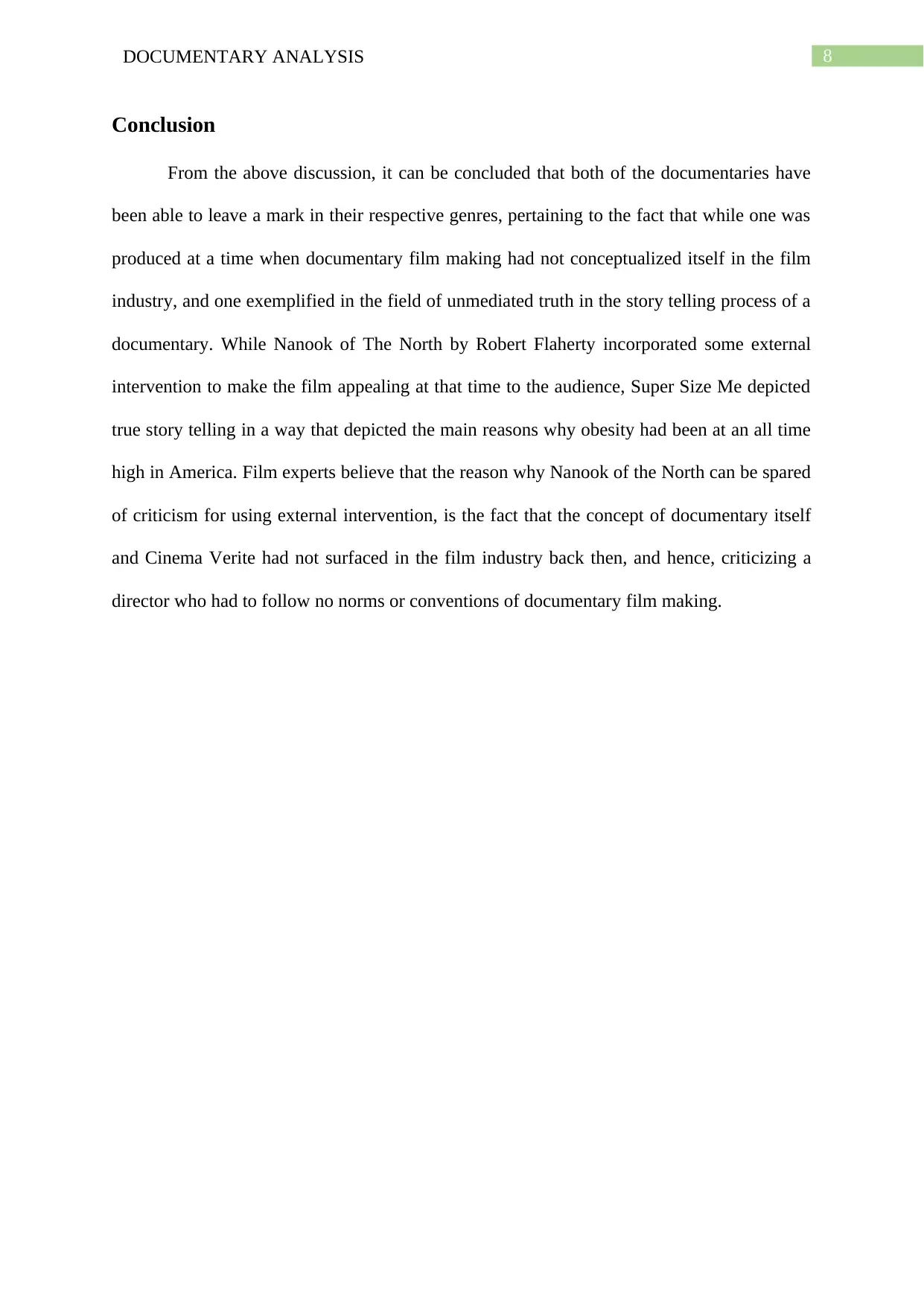
8DOCUMENTARY ANALYSIS
Conclusion
From the above discussion, it can be concluded that both of the documentaries have
been able to leave a mark in their respective genres, pertaining to the fact that while one was
produced at a time when documentary film making had not conceptualized itself in the film
industry, and one exemplified in the field of unmediated truth in the story telling process of a
documentary. While Nanook of The North by Robert Flaherty incorporated some external
intervention to make the film appealing at that time to the audience, Super Size Me depicted
true story telling in a way that depicted the main reasons why obesity had been at an all time
high in America. Film experts believe that the reason why Nanook of the North can be spared
of criticism for using external intervention, is the fact that the concept of documentary itself
and Cinema Verite had not surfaced in the film industry back then, and hence, criticizing a
director who had to follow no norms or conventions of documentary film making.
Conclusion
From the above discussion, it can be concluded that both of the documentaries have
been able to leave a mark in their respective genres, pertaining to the fact that while one was
produced at a time when documentary film making had not conceptualized itself in the film
industry, and one exemplified in the field of unmediated truth in the story telling process of a
documentary. While Nanook of The North by Robert Flaherty incorporated some external
intervention to make the film appealing at that time to the audience, Super Size Me depicted
true story telling in a way that depicted the main reasons why obesity had been at an all time
high in America. Film experts believe that the reason why Nanook of the North can be spared
of criticism for using external intervention, is the fact that the concept of documentary itself
and Cinema Verite had not surfaced in the film industry back then, and hence, criticizing a
director who had to follow no norms or conventions of documentary film making.
⊘ This is a preview!⊘
Do you want full access?
Subscribe today to unlock all pages.

Trusted by 1+ million students worldwide
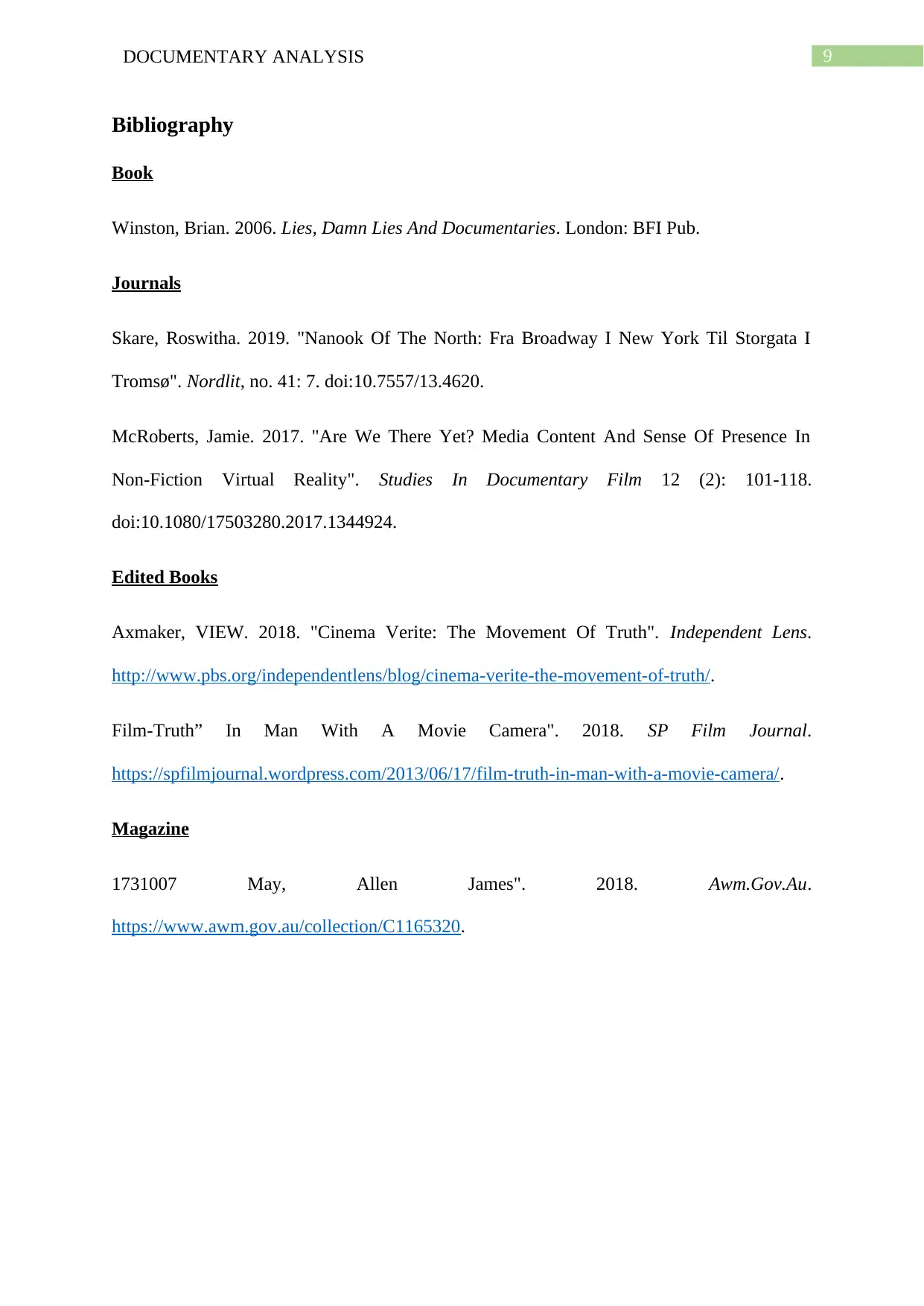
9DOCUMENTARY ANALYSIS
Bibliography
Book
Winston, Brian. 2006. Lies, Damn Lies And Documentaries. London: BFI Pub.
Journals
Skare, Roswitha. 2019. "Nanook Of The North: Fra Broadway I New York Til Storgata I
Tromsø". Nordlit, no. 41: 7. doi:10.7557/13.4620.
McRoberts, Jamie. 2017. "Are We There Yet? Media Content And Sense Of Presence In
Non-Fiction Virtual Reality". Studies In Documentary Film 12 (2): 101-118.
doi:10.1080/17503280.2017.1344924.
Edited Books
Axmaker, VIEW. 2018. "Cinema Verite: The Movement Of Truth". Independent Lens.
http://www.pbs.org/independentlens/blog/cinema-verite-the-movement-of-truth/.
Film-Truth” In Man With A Movie Camera". 2018. SP Film Journal.
https://spfilmjournal.wordpress.com/2013/06/17/film-truth-in-man-with-a-movie-camera/.
Magazine
1731007 May, Allen James". 2018. Awm.Gov.Au.
https://www.awm.gov.au/collection/C1165320.
Bibliography
Book
Winston, Brian. 2006. Lies, Damn Lies And Documentaries. London: BFI Pub.
Journals
Skare, Roswitha. 2019. "Nanook Of The North: Fra Broadway I New York Til Storgata I
Tromsø". Nordlit, no. 41: 7. doi:10.7557/13.4620.
McRoberts, Jamie. 2017. "Are We There Yet? Media Content And Sense Of Presence In
Non-Fiction Virtual Reality". Studies In Documentary Film 12 (2): 101-118.
doi:10.1080/17503280.2017.1344924.
Edited Books
Axmaker, VIEW. 2018. "Cinema Verite: The Movement Of Truth". Independent Lens.
http://www.pbs.org/independentlens/blog/cinema-verite-the-movement-of-truth/.
Film-Truth” In Man With A Movie Camera". 2018. SP Film Journal.
https://spfilmjournal.wordpress.com/2013/06/17/film-truth-in-man-with-a-movie-camera/.
Magazine
1731007 May, Allen James". 2018. Awm.Gov.Au.
https://www.awm.gov.au/collection/C1165320.
1 out of 10
Your All-in-One AI-Powered Toolkit for Academic Success.
+13062052269
info@desklib.com
Available 24*7 on WhatsApp / Email
![[object Object]](/_next/static/media/star-bottom.7253800d.svg)
Unlock your academic potential
Copyright © 2020–2025 A2Z Services. All Rights Reserved. Developed and managed by ZUCOL.